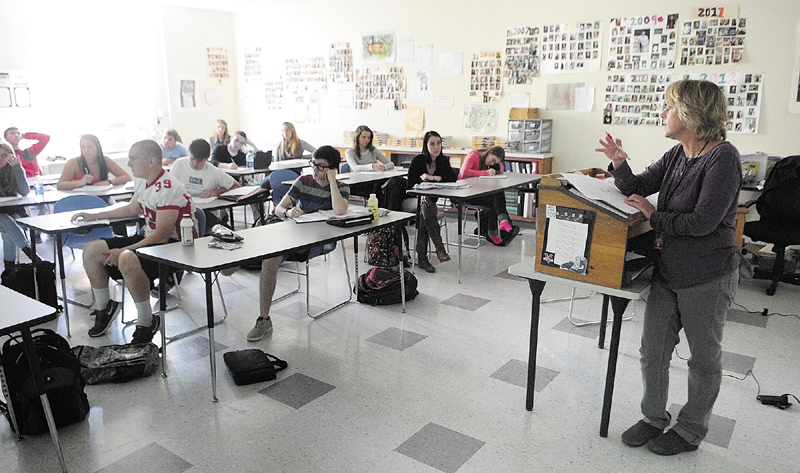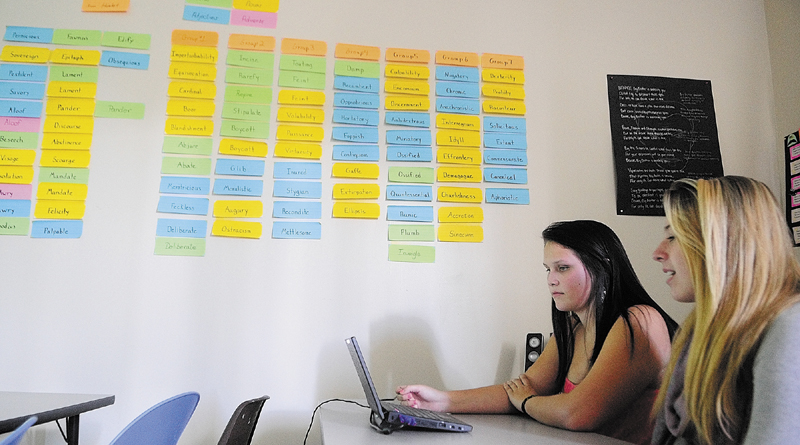AUGUSTA — When SAT scores from the spring arrived at Cony High School in the late summer, school staff felt that three years of hard work were beginning to pay off.
The results weren’t spectacular — about half of students did not meet or only partially met standards on the state-mandated test — but they showed major gains. Cony students’ performance went from significantly below to above state averages, according to results released by the Department of Education last week.
Cony staff said the improvement in performance resulted from strategies introduced in the last three or so years to boost students’ test-taking skills as well as their subject knowledge and skills.
“We were pretty excited,” math department chairwoman Patricia Hannigan said. “We thought it was really great that we did have such a big bump.”
The percentage of last year’s juniors who met or exceeded standards rose from 39.3 to 52.6 in math, from 39.9 to 54.3 in reading and 36.4 to 48 in writing.
Statewide proficiency rates on the 2013 SAT were 48.1 percent in math, 48.9 percent in reading and 43.7 percent in writing.
Cony Principal Kim Silsby acknowledged that the school faces more of a challenge with the science portion of the Maine High School Assessment, which is separate from the SAT. On the science test, the percentage of students meeting or exceeding the standard rose from 32.7 to 34.9. The statewide proficiency rate is 41.3 percent.
Only two other high schools near Augusta — Monmouth Academy and Messalonskee High School — joined Cony in improving student performance on all four sections of the Maine High School Assessment.
Hannigan and math department chairman Tom Wells said Cony probably got a bit of a boost from the particular makeup of the class that took the SAT this year. Wells said the students on average are better off socio-economically than most Cony classes, and they’ve always performed well on standardized tests. Standardized test scores often track closely with economic status.
The staff also believe, however, that the school’s recent emphasis on preparing students for the SAT raised scores this year and will continue to help future students, regardless of their background.
Silsby said administrators made SAT performance a priority a few years ago not only because it’s the state test for high schools, but also because it could help college-bound students. The administrators consulted with the faculty and devised several strategies.
Cony students take the PSAT, a preliminary test, in the fall of their sophomore and junior years. All Maine students take the PSAT as sophomores, but two years ago the state made it optional for juniors and ceased to pay their test fees.
The staff analyzed individual students’ PSAT results to identify their strengths and weaknesses.
Silsby said one factor they found in common among students performing substantially below proficiency was a tendency to stop reading text passages before finishing them. As a result, teachers of all subjects added more exercises where students read and responded to passages.
Wells said the emphasis on reading and doing “quick write” assignments in every subject has helped boost overall literacy.
The English teachers are spending more time on syntax and grammar, which Wells said were de-emphasized in the 1990s as part of an approach to literacy that depended on students picking up skills from reading.
“We’ve accepted the fact that because of technology and society the way it is, we are not getting the same product,” Wells said. “Kids don’t read nowadays, when they have so many distractions, and it obviously affects achievement.”
Cony’s English department has led workshops about assigning and assessing writing for the other teachers, and Wells said he appreciates the way other departments have stepped up.
When a class covers a topic likely to appear on the SAT, like functions or quadratic equations for a math class, teachers incorporate questions from past SATs. Students also review SAT questions in their adviser groups, which meet once a week.
Hannigan said SAT questions contain twists and tricks, which test critical thinking skills but also trip up smart students.
“Knowing how to take the test and what the test looks like is half the battle,” she said. “A few years ago, I think they were going in not being as familiar.”
Students receive more intensive test preparation through an elective, nine-week SAT class and SAT Academy, which consists of a few crash-course review sessions for juniors in the month before the test.
Even with all the emphasis on the SAT, Hannigan said the school is not “teaching to the test” because the topics they’re covering would be in the curriculum anyway.
While Cony staff are happy with the new results, Wells said a standardized test can’t capture the whole picture. Faculty at the school rely on their own assessments to check individual students’ progress throughout the year.
“I teach AP Composition, and I know that when kids leave my class at the end of the year, they can write a college-level paper, but the (test) results don’t always support that,” Wells said. “There’s a disconnect there that I can’t explain. There’s no test out there that truly captures our students’ progress.”
Susan McMillan — 621-5645
smcmillan@centralmaine.com
Send questions/comments to the editors.




Success. Please wait for the page to reload. If the page does not reload within 5 seconds, please refresh the page.
Enter your email and password to access comments.
Hi, to comment on stories you must . This profile is in addition to your subscription and website login.
Already have a commenting profile? .
Invalid username/password.
Please check your email to confirm and complete your registration.
Only subscribers are eligible to post comments. Please subscribe or login first for digital access. Here’s why.
Use the form below to reset your password. When you've submitted your account email, we will send an email with a reset code.